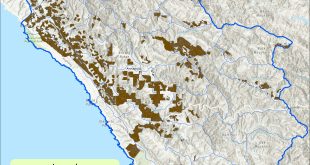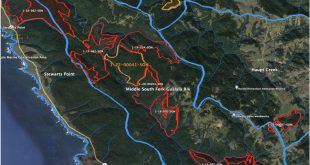| A version of this article was published in the Independent Coast Observer on May 2, 2003. |
The agencies could not agree on how the owner could log the steep, inner gorge and still protect fish in the creek and the ability of the land to grow more trees.
The plan covers 55 acres, and would log about 40 acres. The trees are in the midst of a larger forest of debated size, somewhere from 800 to 2,000 acres.
About 40 people, including representatives from Sate Senator Wes Chesbro (D-Arcata) and Assemblymembers Patty Berg (D-Eureka) and Pat Wiggins (D-Santa Rosa) sat in on the deliberations over the Timber Harvest Plan.
The THP is proposed by landowner Harold Richardson and was prepared by his younger relative Charles Richardson, a Registered Professional Forester.
Review Team Chair Anthony Lukacic of the California Department of Forestry opened the meeting by admonishing the public to behave. He said that Richardson, the RPF who prepared THP 1-00-484 SON, titled “If I would have only known,” had answered all previous written questions to CDF’s satisfaction, but the Department of Fish and Game and the Water Board still raised written objections.
Dave Hope and Jim Burke from the Water Board were not satisfied with the RPF’s response. Hope said he would like to go back to the THP site and do more measurements with a solar pathfinder device to see which trees actually provide shade to the stream. He observed trees much more than 50 feet from the stream shading it, because the slopes are so steep.
Stacy Martinelli from the Department of Fish and Game said she wants to go back and look at the effect cutting the trees could have on the beneficial uses of water such as providing habitat.
Haupt Creek is a tributary of the Gualala River, listed under the federal Clean Water Act as impaired by too much sediment and by water that is too warm for salmonid fish. The agency reps referred to this legal constraint often, and also to constraints in the state forestry rules.
Keeping the water cool is especially important in this part of the creek, Hope said, because landslides on a downstream property force the stream underground except during high water when the fish return to upper tributaries to spawn.
“Fish that are up there are trapped there all summer long,” said Hope, which doubles the concern for them. “They cannot go elsewhere.”
Hope said the forester had not taken the landslides into account in preparing the THP, which requires analysis of cumulative effects – what the proposed logging could do added to past and future land uses in the area. The Richardsons also intend to use their neighbor’s road to reach their THP, so that road is part of the THP, Hope said.
Lukacic said the California Geological Survey wrote that the likelihood of more landslides caused by logging the THP is low. Hope asked where the science came from.
“It’s from observation,” Lukacic said, most of it on Caspar Creek near the village of Mendocino. Titters rippled among the public who knew the sites are very different.
“I’m not allowed to fly with that,” said Hope. Lukacic moved on to another Water Board concern, the re-growth of conifers. Hope said as an RPF he doubts that conifers would grow back on such a steep, south-facing slope, which overhangs in places.
“We had trouble standing on it, let alone evaluating it,” Hope said. He also objected to a road placement. If moved 60 feet, the road would spare a small grove of large, old-growth redwoods.
“To put a road through there makes no sense at all,” said Hope, adding that it would reduce the future productivity of the forest because stump sprouts from the trees could not grow in a road. The Forest Practice Rules call for protecting forest productivity, he said.
“I will take note of that alternative,” said Lukacic. Stating that Water Board staff stands by no clear-cutting on the THP, he turned to Stacy Martinelli of the Department of Fish and Game for comment.
The Sonoma tree vole, a mouselike mammal formerly called the red tree vole, occurs throughout the plan and nest locations need to be documented, Martinelli said, because this grove could be important habitat for them on a regional level. She also wants all trees mapped.
“These are massive trees – do it properly. Do it all.” Martinelli said she stands by her written recommendations, adding that DFG is responsible not only for fish and mammals, but for mosses and insects, and small species unstudied or undiscovered that could be living in an old-growth forest.
Lukacic addressed the public to see if they wanted a break. “You’ve all been very . . . nice,” he sad. They laughed and agreed to more debate, which led to the decision being put off for lack of information.
Helen Libeu, a member of the Foresters Licensing Board, objected to the delay, saying that fewer people would be able to attend each meeting, until eventually, something would be approved.
The public comment period remains open indefinitely. Lukacic said that comments must be in writing to become part of the public record.
| For more information, see: Haupt Creek summary page |
 Friends of Gualala River Protecting the Gualala River watershed and the species living within it
Friends of Gualala River Protecting the Gualala River watershed and the species living within it


